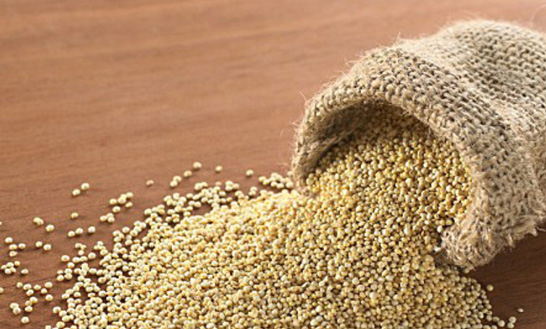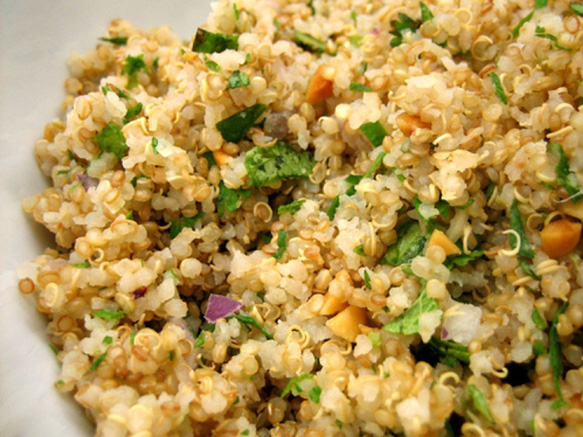
Welcome my dear readers to this new edition of food trends where I follow what’s hot and what’s not and dish it out to you my lovely readers! Today’s edition is on the wonderful substitute Quinoa.
The word “quinoa” is pronounced “KEEN-wah.” It comes from the Spanish word, quinua, which itself comes from the word “kinwa” or “kinua” in the Quechua dialect.
Quinoa History
The Inca (the founding tribe in South America) referred to quinoa as the “mother seed,” and considered it to be sacred. They grew quinoa in South America in the high altitude of the Andes. It was also their staple food for 5,000 years.
The Spanish conquistadors, not knowing its value, almost wiped out quinoa by making it illegal for Native Indians to grow. In the 1980s, two Americans rediscovered quinoa and started growing it in Colorado.
The Food and Agricultural Organization of the United Nations (FAO) has officially declared that the year 2013 be recognized as “The International Year of the Quinoa.” Proposed by the government of Bolivia and receiving strong support from many Central and South American countries, quinoa has now been singled out by the FAO as a food with “high nutritive value,” impressive biodiversity, and an important role to play in the achievement of food security worldwide. I do realize that quinoa remains unfamiliar to many people, especially in the practical sense of cooking and recipes. But that situation is changing, Somehow, a superfood that only health advocates like me have known about for years is now becoming a new wave for twentysomethings and older eating it at trendy coffee shops and delis.
In all fairness, given the remarkable nature of this easily-prepared, nutrient-rich food am not surprised as to how it’s fast catching on. Although there is no accounting for taste or trends, quinoa does have some powerful health benefits. It tastes great, it is high protein, and it is part of another major food trend of today: gluten free eating.
Although referred to as a grain, quinoa is actually a seed from a vegetable related to Swiss chard, spinach and beets.

7 Health Benefits of Quinoa
1. High in protein — its protein balance is similar to milk and has more protein compared to rice, millet or wheat.
2. A good source of riboflavin — riboflavin helps reduce the frequency attacks in migraine sufferers by improving the energy metabolism within the brain and muscle cells.
3. The saponins from quinoa are used to promote healing of skin injuries in South America, making it a good antiseptic.
4. It’s alkaline-forming. Although it is not strongly alkaline-forming, it is comparable to wild rice, amaranth, and sprouted grains.
5. It only has 172 calories per ¼ cup dry quinoa.
6. Since it is not related to wheat or grain, it’s gluten-free. I and Millions other people are discovering they feel better and lose weight when they reduce gluten grains or at least wheat products.
7. It is a complex carbohydrate with low glycemic index. This is again good for weight management. Some studies also show quinoa flour to have higher-than-expected digestibility, which is another wordI love to hear! J
8 Most importantly my favorite part, recent studies have shown that quinoa does not get oxidized as rapidly as might be expected given its higher fat content. This finding is great news from a nutritional standpoint. Meaning the processes of boiling, simmering, and steaming quinoa do not appear to significantly compromise the quality of quinoa’s fatty acids, allowing us to enjoy its cooked texture and flavor while maintaining this nutrient benefit.
Quinoa Caution
Quinoa is coated with toxic chemical called saponin. It is therefore important to rinse quinoa thoroughly. And moderation is key — even with healthy superfoods — so it shouldn’t be eaten every day. A few times a week is enough.
Interesting Facts:
- In South America they use the saponin removed from the quinoa as detergent for washing clothes.
- The sticky, bitter, soapy film of saponins also keeps birds from eating the quinoa seeds off of the bushes. Scientists decided to create quinoa that didn’t have saponins, and guess what? The birds ate it all.
- More than 200,000 pounds are grown each year in the US Rocky Mountains.
- Quinoa is the sweetest tasting when grown above 12,500 feet.











